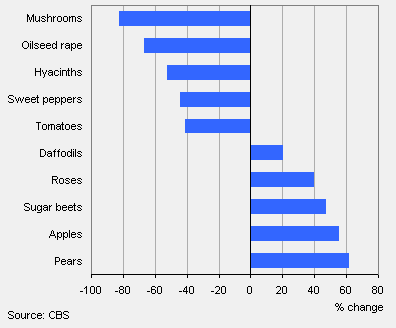Fewer pesticides used in vegetable growing

Between 2000 and 2008, the use of chemical pesticides in vegetable growing, in the open and under glass has dropped sharply. In mushroom cultivation, the use of pesticides has been reduced to a fraction of its former use. Nevertheless, farmers and market gardeners do not manage to bring down the total use of pesticides in arable farming and market gardening.
6.9 kg per hectare in agriculture
Farmers used 6.9 kg of chemical pesticides per hectare (ha) in 2008, versus just over 6.6 kg in 2004. Lily bulb growers use nearly 100 kg per ha, as lily bulbs are susceptible to viral diseases. Rose growers use 86 kg per ha.
Between 2000 and 2008, the use of pesticides per surface unit in lily bulb cultivation was reduced, whereas in rose growing the use increased by 40 percent. In apple and pear growing regions, the use of pesticides has also increased, but the use was exceptionally low in 2000.
More than 12 kg of pesticides per ha were applied in ware potato cultivation in 2008, the same amount as in 2000 and 2004. In mushroom cultivation, the use of pesticides dropped dramatically from nearly 25 kg per ha in 2000 to 4.5 kg in 2008. In paprika and tomato cultivation, the reduction was also remarkable.
Use of pesticides by type of crop, 2000-2008

Decrease pesticide use in flower bulb cultivation, increase in flower cultivation under glass
With 42 and 32 kg per ha respectively, the use of pesticides is highest in flower bulb cultivation and flower cultivation under glass. In flower bulb cultivation, the amount of pesticides applied per ha was cut by 10 percent between 2000 and 2008. In flower cultivation under glass, the amount increased by 14 percent over the same period. In vegetable growing in the open, the use of pesticides was cut noticeably by over 40 percent.
Use of pesticides by sector, 2000-2008

Pesticide use stable in the long run
In 2008, the sector agriculture used 5.6 million kg of pesticides, as against 5.5 en 5.3 million kg in 2004 and 2000 respectively. The use of fungicides, the largest group, is also stable.
Pesticide use by application

Shift in selection of pesticides
Since 2000, various substances have increasingly dominated the market. The most important fungus killer accounted for more than 26 percent of total use in 2008. Yet, various other more recently introduced substances are also used.
Remko Holtkamp and Rob Vijftigschild